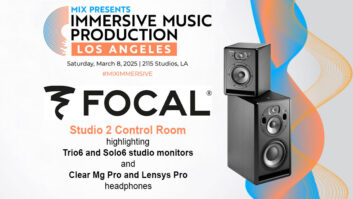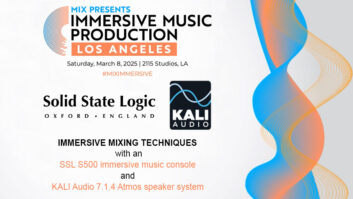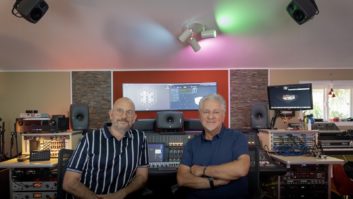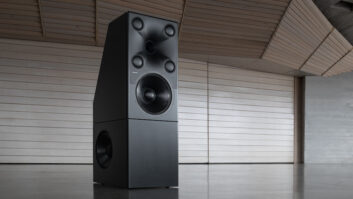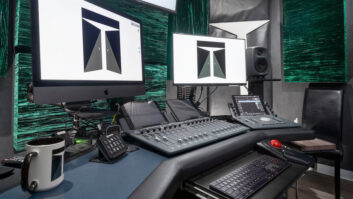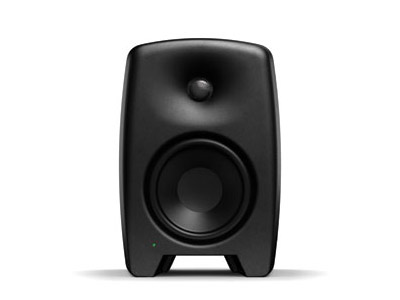
Genelec speakers, manufactured since 1978, are as common today in professional recording environments as the venerable Yamaha NS-10s were in the 1980s. Various models have become staples for recording, editing and mixing, but for some budgets these transducers are just out of reach. By introducing the M-Series (M030 and M040), Finland-based Genelec brings a more-affordable design to project studio owners.
A New Category
Genelec is marketing the M-Series as a “Music-Creation” device. You won’t find it on the company’s Website under Pro Monitoring; the M-Series monitors have their own category. Touted as being environmentally friendly, the M-Series boasts a Natural Composite Enclosure. Fully recyclable, Genelec states the construction comprises an injection molded, natural fiber composite material. The edges are rounded, to reduce edge diffraction, and the box is not perfectly squared: the sides, top and back have a slight arc to them, no doubt to diminish the edge diffraction characteristic of hard-edged speaker enclosures, as well as minimize internal resonance and standing waves.
The bottom of the speaker has integral rails that run from front to back, bringing the enclosure off of its selected perch, thereby reducing acoustic coupling with the bridge, stand, desk, etc. The bass ports, known as the Laminar Integrated Ports, are also designed into these legs, or rails, making placement critical for linear bass response. I found big differences in response depending on what I sat the speaker on, and the bass reproduction is smooth, if not slightly anemic, when pushing high SPLs. Some musicians will likely add a subwoofer for high-SPL low end.
The tweeter rests in the Direct Control Waveguide, which provides time-alignment with the woofer and a wide dispersion of the top end. These designs, working together, provide an extremely wide sweet spot. The imaging is extraordinary. I used them in several locations—free space, on the bridge, against a wall—and found the imaging and instrument placement exceptional, in both the horizontal and vertical axes, with a well-defined sound stage.
Start Me Up
The M040s are powered by Class-D amplification, which makes for a much lighter and cooler-running system—easy to pack and take on location recordings. The 6.5-inch woofer gets 80 watts, with 50 watts heading to the tweeter. Frequency response is published at 48 Hz to 20 kHz (-3dB). The crossover point is at 2.5 kHz on the M040. Genelec does not publish the design characteristics of the woofer, and simply says the tweeter is a metal dome. Having listened to Genelecs for many years, I can say that the upper midrange and top end have that characteristic sound: extreme detail in the vocal range, with a smooth top end, lacking any definitive peaking or ringing.
The first thing I noticed when setting up the speakers was the non-polarized 2-slot power cord–NEMA 1-15 to C7. Genelec states that it has met all the necessary compliance standards to provide this ungrounded plug. Don’t lose it! The mains connect vertically, allowing the speakers to be placed closer to a boundary. A combo TRS/XLR connector and standard unbalanced RCA connections provide signal input.
Signal input level is controlled by a toggle switch, with settings of -20 dB, -10 dB and 0 dB. The M040s also provide a degree of bass equalization, with Bass Level Control at 0 dB, -2 dB and -4 dB, starting the descending shelf at 800 Hz with the down-point at 100 Hz. This can provide a certain level of control when using the speakers against a wall, or in a corner. Bass EQ starts a -2dB decrease in response, starting at 200 Hz down to 50 Hz, with 80 Hz being the -2dB down point. All of these settings are very usable when attempting to tame an unruly, nonlinear room. Table Top EQ kicks in a filter at 210 Hz, lowering that frequency by 3 dB. Again, it’s a usable control, if not entirely flexible in the selection of additional response curves for varying acoustic anomalies.
Following along the “green” path of design, the M040 employs Intelligent Signal Sensing, ramping up the amplifiers with an approximate 2-second delay from standby mode. If the ISS circuitry does not see signal, it puts the amplifiers in standby mode, thereby only requiring 0.5W in power consumption.
Genelec is thorough in its recommendations for speaker placement, with associated diagrams offering some ideas on where to put the speakers and how to set the EQ and level controls. There are no VESA mounts on the back, so placement is limited to a speaker stand or a surface.
Places! Music Please!
I started with the speakers mounted on stands in free-space. The first thing I noticed was the exceptional imaging, particularly in the horizontal axis. There is a good, solid sense of phantom center, along with the separation of instrumentation, producing a well-defined sound stage. They did seem lacking in bass response, but this is a 6.5-inch speaker; it’s not expected to go down to 20 Hz! So, by switching speaker locations with my reference speakers, I found that I could acoustically adjust the space for a more accurate playback.
My speaker stands have two thin strips of rubber on the platform, just enough to raise the speaker slightly off the metal base, so the effect of the down-firing bass port was not skewed by the surface. When placing them on a pair of Primacoustic Recoils (across the bridge), I also used two very thin layers of acoustic foam, one on each rail, obtained from an Auralex MoPad, in order to get the correct angle toward the primary listening position. This setup smoothed out the bass response, if not somewhat increasing the acoustic output at this position. The next test was to remove the MoPads; this changed the bass response slightly, for the better. I then pulled the speakers from the center of the Recoils, to the front edge. This too changed the bass response, but now, it was too much. Conclusions? Placement is critical, as with any speaker, but the down-firing bass port lends a new twist in determining proper placement for accurate response.
Listening to my usual known musical references, I found that vocals were exceedingly well defined. Acoustic guitars sounded natural and present, with an accurate reproduction of the harmonics. The upper bass can start to mask other frequencies, until you get the placement, EQ and levels dialed in. Still, this is going to be characteristic of a smaller speaker design. The bells of Beethoven’s “Wellington’s Victory” were distinct in their rich harmonic structure, with the horns clear and realistic. The M040s produced a deep acoustic space that had no smearing.
String sections sounded natural, with fluid-sounding bowing and no trace of harshness. Electronica and EDM pure waves were also reproduced accurately, without distortion. Some of my Dimmu Borgir (heavy metal) tracks started getting some separation issues in the 3 to 5kHz range, as there is a lot of energy coming from the cymbals, guitars and machine-gun kick drums, but that build-up can happen with just about any two-way speaker system. Pianos had that “present” Genelec sound—again, well defined, without a midrange build-up or nasal quality.
The M040 speakers can easily be learned. I found that while both tracking and mixing, the results were reproduced smoothly and accurately on other systems. Every speaker has its own characteristics, and I found that the M040s truly excel in the detail of the vocal range (with punch!) and separation throughout the frequency spectrum. After listening to them for hours on end, mixing and editing, I experienced little, if any, listening fatigue. They really start to “light up” around 92dB SPL.
Take It to the Bridge
This new category for Genelec is obviously targeted at the project and home studio markets. With that said, affordability is of utmost importance, along with accuracy of reproduction and translation. The M040 bridges the gap between pro monitoring and the hobbyist, with a speaker system that is not only state-of-the-art “green,” but can reproduce, quite accurately, the critical midrange, as well as provide separation of instrumentation throughout the audible spectrum.
The M040s are not exactly bargain basement and are priced with the focused professional in mind: one who cannot quite afford Genelec’s high-end monitors but wants the same timbre characteristics of the larger production house. With proper physical placement and an added subwoofer, the M040s will provide a good, working transduction tool to get your mixes to a closer point of transferability.
Bobby Frasier is an author, engineer, educator, guitarist and lover of all things Beatles.
Product Summary
COMPANY: Genelec
PRODUCT: M040 monitor
WEBSITE:www.genelec.com
PRICE: $995 each
PROS: Light, easy to take on location. Environmentally friendly. Beautiful imaging. Exceptional midrange separation. “Un-hyped” bass response.
CONS: Limited EQ and level controls. Down-firing bass port demands critical placement. No networking.
Try This
Have your hearing checked! How will you know what you are really hearing unless you know your main references: the biometric transducers on the side of your melon. I know some engineers that “don’t want to know,” but this is a critical part of the mixing chain. This will give you an idea of what you are really hearing. Everybody hears differently, and some Grammy Award–winning engineers have less than perfect hearing; they simply know how to work around their limitations to get great results. The more information you have, the better off you are when tracking, editing, and mixing.
